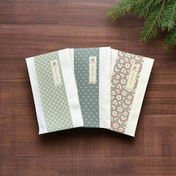An Ingredient behind Traditional Japanese Foods
Sake, miso, shoyu, and mirin, have you heard of these Japanese words and do you know what they are?
Even if you are not familiar with Japanese food, you may have heard of them. These are traditional Japanese foods and have been used in many different ways in Japanese cuisine.

From the left- Sake (rice wine), miso (miso paste), shoyu (soy sauce) mirin(sweet sake)
There is an indispensable ingredient for making all of them, and you can't talk about traditional Japanese foods without it. Do you know what it is?
It’s something called koji !!
What is Koji?
Koji (sometimes written as kōji or kouji) is a cooked grain (rice, soybeans or barley, etc) that has been inoculated with a fermentation culture called Aspergillus oryzae, koji mold. Koji is prepared by adding koji mold to steamed grains, then carefully kept in warm, humid conditions that promote growth.
This is koji rice. Rice is the most frequently used grain for making koji.

Koji rice is used for making sake, miso, shoyu, mirin as shown above, also for making amazake(traditional drink), pickles, condiments, etc. In other words, all these foods are fermented by koji mold. So many Japanese foods have been developed over the centuries with koji. Koji is the mold behind Japanese food production!
There are some foods fermented by mold in the west, such as cheese and a type of wine called "noble rot". However, there is nowhere like Japan using the same mold for making such a variety of foods.
There must be some secrets why people have been using koji so much. Let's find out.
The Secret of Koji
During the fermentation process, koji mold produces over 100 types of enzymes. Two types of enzymes called proteases and amylases are the key to fermentation.Proteases break proteins into amino acids, such as glutamate, which imparts an intensely savory taste known as umami. Amylases break starch into glucose(sugar) which creates sweetness.
Therefore, foods with koji have a deep flavor with umami, sweetness and a special aroma from the fermentation.
Also, the enzymes help your digestion and boost your immune system, and koji gives us various nutrients such as B vitamins and minerals.
Koji creates a nice flavor, and is good for your health, so it is no wonder koji has been used so much!
Koji Revival in Japan, and Around the World
To be honest, koji itself has not been so familiar to us recently, compared to old days when people made miso and/or shoyu at home themselves. There used to be a koji shop in our home town, and my grandparents used to buy koji there and made their own miso and shoyu.
However, for the last 10 years or so, koji has come back into the Japanese kitchen! Koji has come to prominence as a condiment with salt, which is called shio-koji, salted rice koji. There have been lots of salted rice koji and koji itself for sale in stores. People have started buying koji again!
As for the past 3-4 years, because of the pandemic, people have thought about their food life, and cooked at home and made fermented foods with koji. You can see lots of fermented food recipes with koji. I, personally, have had a stock of rice koji in my kitchen shelf, and enjoy using it, for making dressings, drinks, cakes and ice creams, etc.

Mango icecream with koji (vegan)
It seems people around the world are also taking note of koji too. Top-class chefs in the USA and France have begun to highly appreciate salted rice koji as they say it enriches the flavor components of whichever foods it is added to.
Koji has been used for more than 1000 years, and now, still developing the ways of using it.
Recipe
Shio-koji (Japanese fermented condiment) Recipe
You can make shio-koji at home!

Today's Recommendations
This is the most common type of koji made with steamed rice.
This koji is made with brown rice, which means it contains lots of vitamins, minerals and fibers, and you can use it in the same ways as usual rice koji.

Osada Tea: Organic Yamabuki Nadeshiko, Kurokoji Fermented Tea 有機山吹撫子
Kurokoji (black koji) is used for this tea as a starter for fermentation. More information from the product page.



